I had to work the day before the event, so I was
up late getting the boat loaded and hooked up, and probably didn’t
do the most organized job of it. Still, I was more or less ready,
and the forecast looked pretty good – light winds and flat
water. Once again, I should never have trusted the NOAA broadcast.
I didn’t arrive in Alabama until about 4 hours after the
fleet left– I had stuff I needed to do that morning. But
once launched, and after beating out the narrow entrance to the
bayou into the teeth of a 15 to 20 knot breeze from the SE, I
set off to catch up.
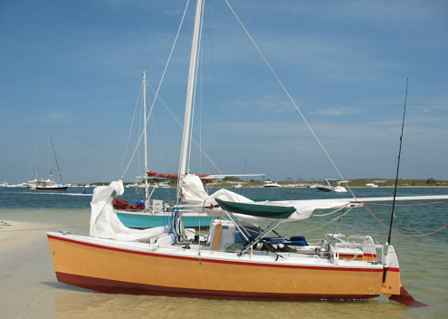
Even though the course was dead to windward, I was lucky. Because
of the delay, I had the tide under me when passing through Perdido
Key bridge. The fleet had to fight the tide and the wind, and
a few boats had to break out their motors to get through. This
wasn’t an option for me, so I was grateful that my timing
was good. Sailing without an engine is usually not a problem here
along the NW Florida coast, since winds are pretty reliable and
tides are modest. But at choke points like bridges and inlets,
the currents can be intimidating, and those big rough fender walls
can do a lot of damage to a sailboat, if you get pushed up against
them.
Later in the weekend I had some fun showing folks my GPS tracks
through the narrows by the bridge, because the track looked like
I was tacking at a thoroughly amazing angle to the wind. The smart
sailors quickly figured out that I’d had the tide with me,
and I’d have to admit that Slider was pretty good to windward,
but no sailboat is that good.
I made it to the campsite on Sand Island at sundown, waved at
the fleet camped there, and anchored across the gut in the Schooner
Hole below the ruins of old Fort McRee, where we used to anchor
when the kids were young and we had a big cruising boat. I remember
one evening when we were sitting out in the cockpit, watching
a heron stalk along the shoreline. To our astonishment, and slightly
horrified fascination, he grabbed a four foot snake out of the
reeds and swallowed it right down.
A heron came by while I was sitting on my cot on Slider’s
center deck, but the best he could manage was a couple of minnows.
I was tired, and sleep came quickly.
The next morning the wind was still howling out of the SE, and
the tide funneling through Pensacola Pass made for some weird
chop. Almost everyone had a rough day beating to windward. Dean
Pacetti in Honu, Slider’s new sistership, took off fast
and built up a pretty good lead on me. Dean is a much better boat
builder than I am, and it looked for a while as if he was also
a much better sailor as well.
I eventually caught up with him, more by luck than skill and
passed him just east of the Pensacola Beach bridge. I’ve
never been very interested in even the idea of racing, let alone
actually doing it. But being in a field of small boats awoke some
weird competitive impulse in me, and I paid a lot more attention
to my sail trim and helmsmanship than I usually do. It added a
new dimension to the sailing that I’d really never fully
appreciated before.
My wife Nancy was quite amused by my sudden transformation into
a competitive sailor. She found it especially funny when I explained
my theory on how to evaluate your boat’s performance in
the fleet. I said something like “well, you count the number
of boats you pass, and subtract the number of boats that pass
you, and that’s your number.” Nancy didn’t come
aboard until Saturday morning, so she was with me on the great
downhill run we had that day, where we passed a half-dozen boats,
and were not passed. I hate to admit how much pleasure I got out
of this.
Some folks have been concerned about the quality of my sailing
experience, due to my claim that Slider is a very dry boat and
we hardly ever have any spray come aboard. Evidently they feel
that if you don’t occasionally get wet, you never go out
in winds over 5 knots. These folks will be glad to know that on
this day, I got wet. Not soaked, but damp– no water made
it into the cockpits, fortunately. However, once in a while the
bows would dig into the back of a wave and toss a little spray
back onto me. It was about as rough as I’ve ever seen it
in protected waters, and it was tough on the boats that didn’t
go to windward well. Scott Widmier, on his tiny scow, had to accept
a tow from a boat with a motor in order to get to Navarre.
Dean in Honu got tired of bashing into the chop and turned back
to Sand Island. I should have followed his example, especially
since I’d discovered a patch of rot in my rear crossbeam
a couple days previously and the repair had not held up to the
constant crashing through the big chop. But the boat was holding
together, despite the fact that one bolt on the beam had broken
out completely, so I pressed on, and eventually arrived in Navarre.
The damage was pretty bad, as can be seen in this photo.
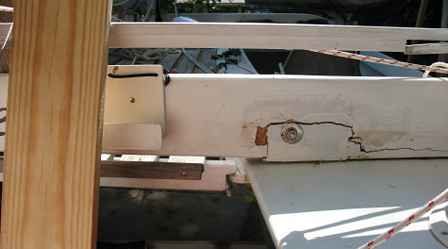
On one tack, the beam looked okay, but on the other, the beam
rose up about an inch. That the boat didn’t break up was
probably due to her extremely rigid construction, with the double
girder system formed by the seat risers and side decks. That one
inch of misalignment was all that the hulls would twist, so they
couldn’t put as much pressure on the beam attachments as
a more limber construction might have allowed. I’m busy
this weekend replacing the rear beam. The new beam cost me $3.79
at Lowe’s, and all I have to do is shape it and re-attach
a few bits of deck hardware. The old beam rotted because I failed
to bed the bolts that attached it to the beam web. I neglected
this because I thought I might have to remove the beams, and then
I forgot I hadn’t bedded them. I won’t make that mistake
again.
Though the beam gave me some anxious moments as we crashed through
the chop at speed, the fact that the boat stayed together in those
conditions has given me a great deal of confidence in Slider’s
construction.
Slider was among the first half-dozen boats to arrive, and some
of those had gotten there by motoring along the windward shore–
a much more peaceful way to make the distance.
One of the big surprises to me was that Slider was faster to
windward, by a large margin, than the two Windrider 17s in the
event. I’d never have guessed that this would be the case,
even though I like to brag about Slider’s windward ability.
One left the previous anchorage before I did, and I passed him
a few miles before reaching Navarre. At this point, the chop was
lying down, and the course became a close reach. I expected the
Windrider to pass me then, but if anything, we increased our lead.
The Windrider 17 is a rotomolded plastic trimaran with a modern
fractional rig, complete with rotating mast, designed by the great
trimaran designer Jim Brown. I found it completely amazing that
Slider, with her greater weight and low-tech sprit-sloop rig,
was so much faster getting to weather.
I spent a peaceful Friday night at Navarre, pulled up on the
beach. I was too tired to pitch the deck tent, so I just snoozed
on a cot set up on deck. I’m told that I slept like a baby,
if babies snored like buzz saws.
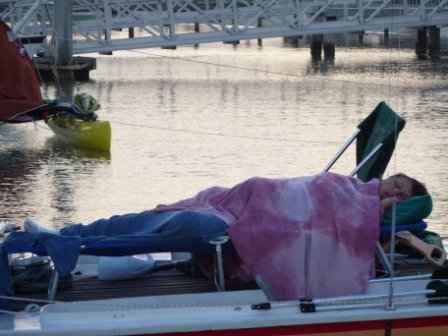
I found this picture on the Florida 120 Facebook page, taken
by Gary Hirsch. I hope he won’t mind if I post it here.
In the morning, my wife Nancy joined me for the downhill run
back to Sand Island. We had a great run, surfing on the little
waves that developed on Santa Rosa Sound, often hitting 8 knots.
Once again, we were faster than the Windriders, though perhaps
the outcome would have been different on a reaching course. It’s
also possible that the Windriders were a little overloaded, carrying
camping gear and supplies for four days and three nights.
The sun was pretty fierce Saturday, and we were running before
the wind, so not much wind was crossing the decks. We were grateful
for the little biminis I installed. These biminis are not very
pretty, because I made them from chopped up sections of bimini
frames I’d found discarded along the curb in our neighborhood.
My right angles were made with PVC pipe fittings, and my sewing
is lousy. Still, they kept the sun off and later would break the
force of the rain we had Sunday morning. This was a good thing,
because Nancy had forgotten to bring her hat. I had to loan her
mine, because her pale skin is much easier to burn than my swarthy
hide.
Dean had spent the previous night at Sand Island, and it was
great to finally get a look at his boat. He’s done a beautiful
job of putting her together, and I hope to steal a number of his
improvements. I took some pictures of Honu and Slider sitting
together on the beach.
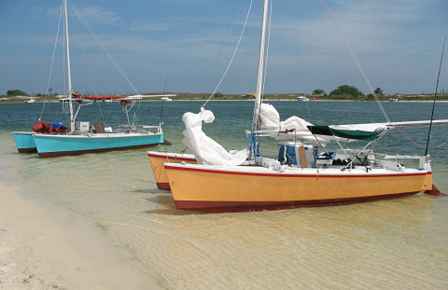
Dean really put a lot of thought into Honu. I wish I’d
taken more pictures. For example, as an experienced waterman,
he’d painted his decks and interior an eye-pleasing gray,
which cuts down tremendously on the glare. He’d built a
really well-organized chuck box, with an easily accessible place
for everything. He’d built little drawers under his seats,
so that snacks and other needed items were easily to hand. He
had a very good system for supporting his mast and boom when they
were down for trailering. Later back at Pirate’s Cove, he
showed me his trailer, which had begun life as a narrow johnboat
trailer. This allowed Honu’s hulls to be outside the wheels,
so that she could be a lot closer to the ground than Slider is
on her trailer. Consequently, he can use just about any ramp,
and Slider has to find a fairly steep deep one.
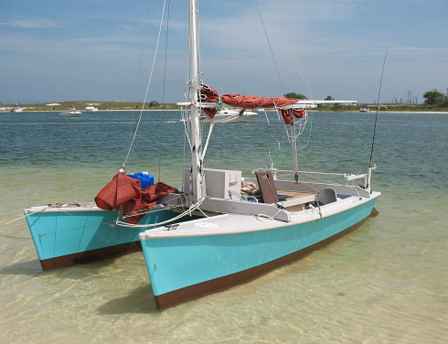
Nancy and I pitched the tent up on the ridge line above the anchorage,
where we had a panoramic view of Perdido Key and the Gulf beyond.
We had a campfire gathering, where the participants told stories
about their experiences, which was wildly entertaining–
some of those guys are truly funny. We all told some little thing
about what we’d learned, our biggest mistake, and so on.
The night was fine, and it only rained a little. But the morning
was gray and ominous. We’d all had enough of banging into
the wind, so the possibility of west winds later in the day caused
everyone to pack up and sail out early, us included. The rain
held off for a while, and the sailing was very pleasant, broadreaching
down Big Lagoon toward Perdido Key bridge. But before we made
it through Big Lagoon, the skies ripped open and the rain poured
down. It killed the wind just as we reached the bridge, but fortunately
the tide carried us through and the wind returned, so we were
able to make Pirates Cove before noon.
We parked Slider on the beach while other folks were hauling
out, and had a breakfast sandwich in the bar– very tasty.
There was one mishap– one of our fellow sailors hauled out
and forgot to put down his mast until he’d hit a power line.
I heard the bang and other folks told me a fireball had traveled
down the shrouds and exited at the left hub. But fortunately no
one was hurt.
We put Slider on her trailer and attended the final meeting of
the cruise, where we distributed some booty according to the poker
hands we’d earned by reaching each of the destinations,
sailing without an engine, and so forth. I contributed a hardly-used
gaff to the pile. My hand was garbage, but I did have an ace high,
so eventually I got my gaff back.
Anyway, we had a terrific time, and I was very glad to see those
beautiful familiar waters one last time… before the oil
arrives.
Ray's
blog: https://slidercat.com/blog/wordpress/?page_id=2
*****

|

